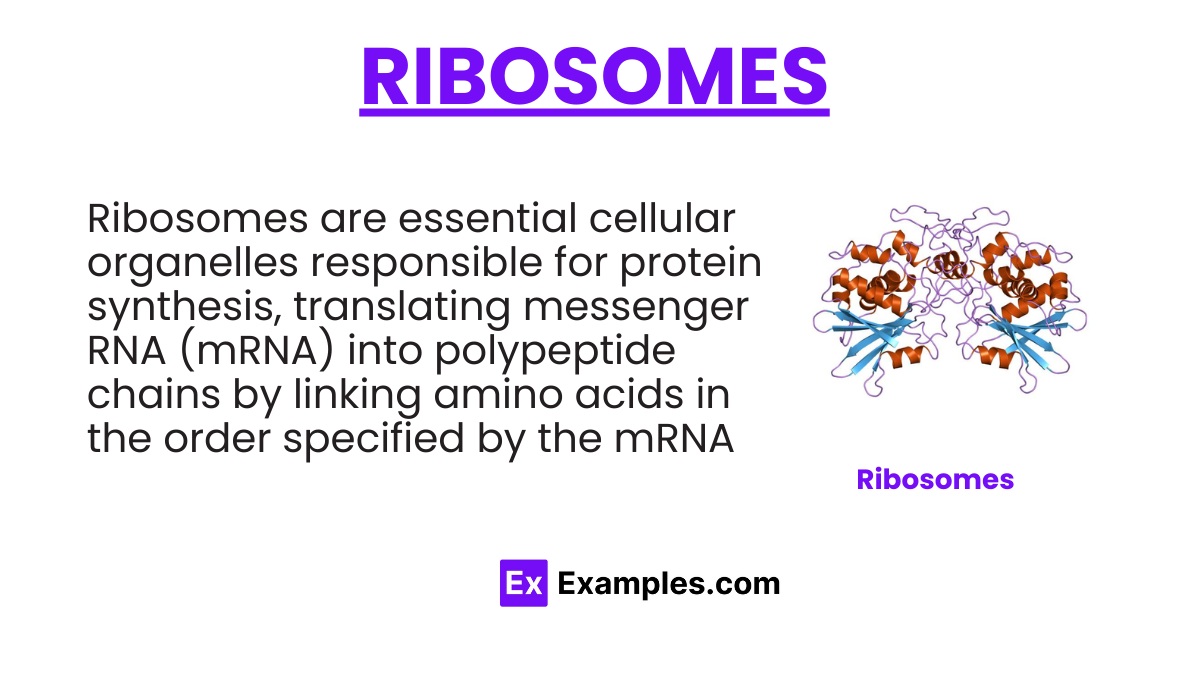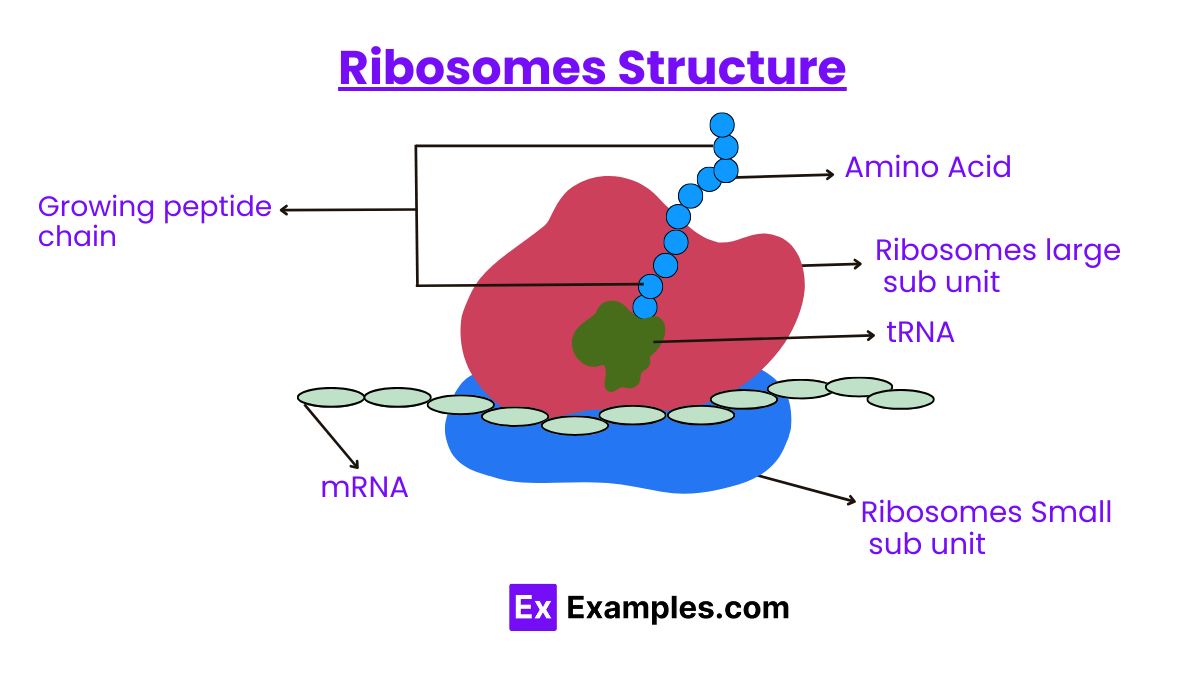What is the primary function of ribosomes in a cell?
Energy production
Protein synthesis
DNA replication
Lipid synthesis


On a fascinating journey into the microscopic world of ribosomes, the essential cellular machines responsible for protein synthesis. Acting as the workbenches where DNA’s genetic instructions are translated into the proteins that power life’s processes, ribosomes play a pivotal role in both the health and the vitality of cells. This guide delves into the structure, function, and significance of ribosomes, illuminated with engaging examples that bring their complex operations to life. Whether embedded in the rough endoplasmic reticulum or floating freely within the cytoplasm, these tiny yet mighty organelles are key to understanding cellular biology. Through a blend of scientific insight and accessible examples, this SEO and NLP friendly introduction offers a comprehensive overview of ribosomes’ role in the fabric of life, making it an invaluable resource for students, educators, and anyone keen to uncover the mysteries of cellular machinery.
Ribosomes are essential cellular organelles responsible for synthesizing proteins, which are crucial for numerous cellular processes. Acting as the site of translation, ribosomes decode the genetic information carried by messenger RNA (mRNA) into polypeptide chains, which then fold into functional proteins. Ribosomes are found in all living cells, including bacteria, archaea, and eukaryotes, highlighting their fundamental role in life.

The structure of ribosomes is crucial to their function in protein synthesis. Ribosomes are complex molecular machines found within all living cells, where they link amino acids together in the order specified by messenger RNA (mRNA) molecules to form proteins. They consist of two main components: the small and large subunits, each made up of ribonucleic acid (RNA) and protein molecules. Here’s a detailed look at the ribosome structure:
Ribosomes are essential cellular organelles responsible for protein synthesis, playing a critical role in translating the genetic code into functional proteins. Below are the key functions and processes involving ribosomes, outlined in a point-by-point format:
Ribosomes play a crucial role in animal cells by synthesizing proteins, which are essential for countless cellular functions. Here are 10 key points about ribosomes in animal cells:
| Feature | Prokaryotic Ribosomes | Eukaryotic Ribosomes |
|---|---|---|
| Size | 70S | 80S |
| Sedimentation Coefficient | 70S (composed of 50S and 30S subunits) | 80S (composed of 60S and 40S subunits) |
| Location | Cytoplasm | Cytoplasm, Rough Endoplasmic Reticulum |
| rRNA Composition | Smaller and slightly different in sequence | Larger and more complex rRNA sequences |
| Protein Composition | Fewer proteins | More proteins |
| Sensitivity to Antibiotics | Often sensitive to antibiotics targeting the ribosome | Generally resistant to antibiotics targeting prokaryotic ribosomes |
| Function | Protein synthesis | Protein synthesis |
| Origin of Assembly | Nucleoid region | Nucleolus |
| Ribosomal Proteins | Imported directly from the cytoplasm | Imported into the nucleus for assembly |
| Associated with ER | No | Yes, in the case of membrane-bound ribosomes |
Ribosomes are tiny, complex molecular machines found in all living cells (eukaryotic and prokaryotic), responsible for synthesizing proteins by translating messenger RNA (mRNA) into amino acid sequences.
In eukaryotic cells, ribosomes can be found floating freely in the cytoplasm or attached to the endoplasmic reticulum, forming the rough ER. In prokaryotes, ribosomes are dispersed throughout the cytoplasm.
Ribosomes read mRNA sequences and translate them into polypeptide chains, which then fold into functional proteins. This process involves decoding the mRNA’s codons and assembling the corresponding amino acids.
A ribosome consists of two subunits: a smaller subunit, which reads the mRNA, and a larger subunit, where peptide bonds form to link amino acids into polypeptide chains.
While ribosomes are essential cellular components, they are not considered true organelles because they lack a membrane.
Ribosome assembly involves the combination of ribosomal RNA (rRNA) and ribosomal proteins. This assembly occurs in the nucleolus (in eukaryotes) before the subunits are transported to the cytoplasm.
Yes, ribosomes in prokaryotes (70S) are slightly smaller than those in eukaryotes (80S), reflecting differences in their RNA and protein content. Despite these differences, the basic function of ribosomes is conserved across all forms of life.
Yes, many antibiotics work by specifically targeting bacterial ribosomes, disrupting protein synthesis without affecting eukaryotic ribosomes, thereby killing or inhibiting the growth of bacteria.
Mutations affecting ribosomal proteins or rRNA can disrupt ribosome function and lead to various diseases, known collectively as ribosomopathies, which often involve impaired cell growth and differentiation.
Ribosomes themselves do not select which proteins to synthesize; instead, this is determined by the mRNA molecules that reach the ribosome, carrying the encoded instructions for specific proteins.
ribosomes are indispensable molecular machines across all life forms, orchestrating the complex process of protein synthesis. Despite their universal role, notable differences between prokaryotic and eukaryotic ribosomes reflect their adaptation to distinct cellular environments. This comparative analysis underscores the intricacies of cellular machinery and highlights the sophistication of biological systems in facilitating life’s fundamental processes.
Text prompt
Add Tone
Ribosomes Structure
Ribosomes Function
What is the primary function of ribosomes in a cell?
Energy production
Protein synthesis
DNA replication
Lipid synthesis
Where are ribosomes primarily located within a cell?
Mitochondria
Nucleus
Endoplasmic reticulum and cytoplasm
Golgi apparatus
What are ribosomes composed of?
Lipids and carbohydrates
Proteins and RNA
DNA and RNA
Carbohydrates and proteins
Which type of RNA carries genetic information from DNA to ribosomes?
Transfer RNA (tRNA)
Ribosomal RNA (rRNA)
Messenger RNA (mRNA)
Small nuclear RNA (snRNA)
What is the role of transfer RNA (tRNA) during protein synthesis?
To decode mRNA
To transport amino acids to ribosomes
To form ribosomal subunits
To transcribe DNA into RNA
Which part of the ribosome binds to mRNA during translation?
Large subunit
Small subunit
tRNA
rRNA
In which part of the cell does translation occur?
Nucleus
Mitochondria
Ribosomes
Golgi apparatus
What distinguishes prokaryotic ribosomes from eukaryotic ribosomes?
Their size
Their location
Their composition
Their function
How does the ribosome ensure that the correct amino acids are added to the protein chain?
By proofreading mRNA
By checking tRNA for proper amino acids
By editing DNA sequences
By modifying rRNA
What happens to ribosomes after protein synthesis is complete?
They are destroyed
They remain bound to the mRNA
They are recycled for new protein synthesis
They move to the nucleus
Before you leave, take our quick quiz to enhance your learning!

